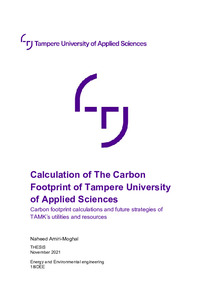Calculation of the carbon footprint of Tampere University of Applied Sciences
Amiri-Moghal, Naheed (2021)
Amiri-Moghal, Naheed
2021
All rights reserved. This publication is copyrighted. You may download, display and print it for Your own personal use. Commercial use is prohibited.
Julkaisun pysyvä osoite on
https://urn.fi/URN:NBN:fi:amk-2021111520286
https://urn.fi/URN:NBN:fi:amk-2021111520286
Tiivistelmä
To combat the problem of climate change, actions need to be taken both individually and by industries to reduce carbon emissions, which are produced by our daily life activities. Together with other universities in Finland, Tampere universities are exhorted to achieve carbon neutrality by 2030. Like the other universities, Tampere University of Applied Sciences (TAMK) is planning to achieve the goal and take measures towards sustainability.
The purpose of this thesis was to calculate the footprint of TAMK and to contemplate ways of reducing the emissions and find possible ways for compensation. The study was conducted by gathering data of TAMK’s utilities and resources.
The results gathered after the calculations show the total emissions reach to 1431,97 tCO2 eq in 2019. The greatest contributor to carbon dioxide emissions is heating, which is approximately 1376,91 tCO2 eq followed by vehicles, which is 26,44 tCO2 eq. Calculations were done for smaller emission contributors as well, such as waste, water, renovation, and maintenance.
The emissions could be reduced by taking measures for different emission contributors. For example, regular maintenance and inspection could reduce the amount of heat loss and would increase heating efficiency. Vehicle emissions can be reduced by replacing the current cars with electric cars. The aim is to reduce carbon emissions as much as possible and since it is not possible to eliminate the emissions completely, the remaining must be compensated.
For future research recommendations, it would be interesting to explore the biodiversity footprint of district heating and calculate per person carbon footprint of students and staff members of TAMK to see how the energy efficiency evolves over the years. This would be beneficial in benchmarking and narrowing down the carbon emissions and its impacts.
The purpose of this thesis was to calculate the footprint of TAMK and to contemplate ways of reducing the emissions and find possible ways for compensation. The study was conducted by gathering data of TAMK’s utilities and resources.
The results gathered after the calculations show the total emissions reach to 1431,97 tCO2 eq in 2019. The greatest contributor to carbon dioxide emissions is heating, which is approximately 1376,91 tCO2 eq followed by vehicles, which is 26,44 tCO2 eq. Calculations were done for smaller emission contributors as well, such as waste, water, renovation, and maintenance.
The emissions could be reduced by taking measures for different emission contributors. For example, regular maintenance and inspection could reduce the amount of heat loss and would increase heating efficiency. Vehicle emissions can be reduced by replacing the current cars with electric cars. The aim is to reduce carbon emissions as much as possible and since it is not possible to eliminate the emissions completely, the remaining must be compensated.
For future research recommendations, it would be interesting to explore the biodiversity footprint of district heating and calculate per person carbon footprint of students and staff members of TAMK to see how the energy efficiency evolves over the years. This would be beneficial in benchmarking and narrowing down the carbon emissions and its impacts.
